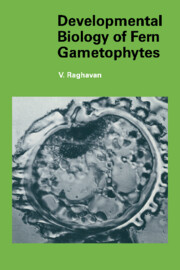Book contents
- Frontmatter
- Contents
- Preface
- Abbreviations
- 1 Introduction
- PART I THE BEGINNING
- PART II GROWTH AND MATURATION
- 6 Developmental physiology of gametophytes – the germ filament
- 7 Developmental physiology of gametophytes – induction of planar growth
- 8 Role of protein and nucleic acid synthesis in planar growth
- 9 Vegetative and reconstitutive growth of gametophytes
- PART III REPRODUCTIVE STRATEGIES
- PART IV DEVELOPMENTAL OPTIONS
- References
- Author index
- Subject index
6 - Developmental physiology of gametophytes – the germ filament
Published online by Cambridge University Press: 11 September 2009
- Frontmatter
- Contents
- Preface
- Abbreviations
- 1 Introduction
- PART I THE BEGINNING
- PART II GROWTH AND MATURATION
- 6 Developmental physiology of gametophytes – the germ filament
- 7 Developmental physiology of gametophytes – induction of planar growth
- 8 Role of protein and nucleic acid synthesis in planar growth
- 9 Vegetative and reconstitutive growth of gametophytes
- PART III REPRODUCTIVE STRATEGIES
- PART IV DEVELOPMENTAL OPTIONS
- References
- Author index
- Subject index
Summary
In all homosporous ferns, except those included in the Marattiaceae and Osmundaceae, the protonema initial generates a uniseriate, elongate filament composed of a varying number of chlorophyllous cells. All division planes leading up to the formation of the filament are oriented perpendicular to the long axis of the cell and thus lie parallel to one another. At each division, new walls are laid down between cells to hold them together as an elongating filament. When the filament has produced a certain number of cells, as determined by the conditions of growth and other factors, its terminal or subterminal cell divides by a wall oblique to the long axis to give rise to a bidirectionally dividing plate of cells. This marks the beginning of planar or prothallial growth. By the continued meristematic activity of this cell, aided later by the establishment of a pluricellular meristem, a flat, often cordate or exceptionally, ribbon-shaped, structure is formed. Rarely, as in Schizaea and Trichomanes (Hymenophyllaceae), no change ever occurs in the plane of cell divisions of the germ filament, which thus retains the basic filamentous morphology throughout the gametophytic phase. In this book, the terms ‘germ filament’, ‘protonemal filament’ or ‘protonema’ (plural, protonemata) are applied to the filamentous gametophyte and the term ‘prothallus’ is used to denote the structure with the planar morphology.
- Type
- Chapter
- Information
- Developmental Biology of Fern Gametophytes , pp. 107 - 129Publisher: Cambridge University PressPrint publication year: 1989
- 1
- Cited by



